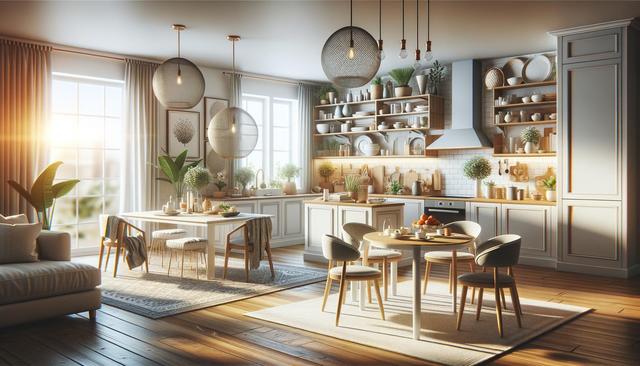Home Remodel Trends Shaping Modern Living Spaces
Home remodel trends highlight sustainability and adaptability. Popular upgrades include smart home technology, energy-saving features, and versatile spaces that can serve multiple functions. A strong emphasis on comfort, wellness, and long-term value is influencing design and renovation decisions.

Smart Technology Integration
One of the most notable home remodel trends is the integration of smart technology throughout living spaces. Homeowners are increasingly adopting automation systems that enhance convenience, security, and energy efficiency. From voice-activated lighting and climate control to smart appliances that can be monitored remotely, technology is reshaping how homes function day to day. These innovations not only add a layer of modern convenience but also contribute to long-term energy savings and efficient resource management.
Features like smart thermostats and lighting systems can learn user habits and optimize energy use automatically. Many are compatible with mobile apps, allowing control from anywhere. Common smart upgrades include:
- Smart lighting and dimmers
- Integrated security systems
- Voice-controlled assistants
- Automated window treatments
These tech-forward improvements make homes more adaptable and ensure they remain current as technology evolves.
Energy Efficiency and Sustainable Materials
Energy efficiency continues to be a top priority in modern renovations. Homeowners are turning to eco-friendly materials and sustainable building practices to reduce their environmental impact and utility bills. This includes everything from solar panel installations to the use of reclaimed wood and recycled materials in flooring and cabinetry.
Insulation upgrades, energy-efficient windows, and low-flow plumbing fixtures are also popular choices. These changes not only cut costs but also appeal to environmentally conscious buyers and renters. Some widely adopted energy-efficient remodel choices include:
- LED lighting systems
- Tankless water heaters
- Low-VOC paints
- High-efficiency HVAC systems
By selecting sustainable options, homeowners can enjoy a healthier indoor environment and contribute to global conservation efforts.
Multi-Functional Spaces
Flexibility has become essential in home design, especially as more people work and study from home. Multi-functional spaces that can adapt to various needs are in high demand. Rather than having single-purpose rooms, many homes now feature areas that can easily transition between a home office, guest room, or exercise space.
Open-concept layouts and modular furniture help maximize the usability of limited square footage. Design elements such as sliding doors, foldaway furniture, and built-in storage make it easier to adapt rooms for different activities. Key strategies include:
- Convertible furniture (e.g., Murphy beds, fold-out desks)
- Partition walls or screens for privacy
- Custom cabinetry for storage optimization
- Neutral design palettes for universal appeal
This trend supports a more dynamic and responsive living environment, ideal for households with changing needs.
Wellness-Oriented Design
Health and wellness are increasingly influencing home remodeling decisions. Creating a home that supports physical and mental well-being is becoming a major goal for many homeowners. This includes incorporating more natural light, improving air quality, and designing spaces that promote relaxation and mindfulness.
Biophilic design is gaining traction, which involves bringing elements of nature indoors through plants, natural materials, and water features. Wellness-focused remodels often include:
- Improved ventilation systems
- Indoor gardens and green walls
- Water purification systems
- Dedicated spaces for yoga or meditation
Such features help create a tranquil environment that contributes to overall quality of life. The emphasis on wellness aligns with broader lifestyle trends focusing on self-care and holistic health.
Timeless Style and Long-Term Value
While trends come and go, many homeowners are choosing remodels that offer long-term value and timeless aesthetics. Rather than chasing fads, there’s a growing interest in classic design elements that will stand the test of time. Neutral color schemes, natural materials like stone and wood, and high-quality craftsmanship are all hallmarks of this approach.
In kitchens and bathrooms, for instance, designs are leaning toward clean lines and durable finishes that won’t require frequent updates. Long-lasting materials and thoughtful layouts not only enhance daily living but also increase a home’s resale value. Popular long-term design strategies include:
- Quartz countertops
- Shaker-style cabinetry
- Engineered hardwood flooring
- Subtle, cohesive color palettes
By focusing on enduring design principles, homeowners can ensure their remodel remains attractive and relevant for years to come.
Conclusion: Embracing Change With Purpose
Today’s home remodel trends reflect a desire for spaces that are not only beautiful but also functional, sustainable, and supportive of well-being. Whether integrating smart technology, improving energy efficiency, or reimagining room layouts, each trend speaks to a broader shift toward thoughtful, future-oriented living. Homeowners who prioritize adaptability, quality, and wellness in their renovation projects are building environments that will continue to serve their needs effectively for the long term.